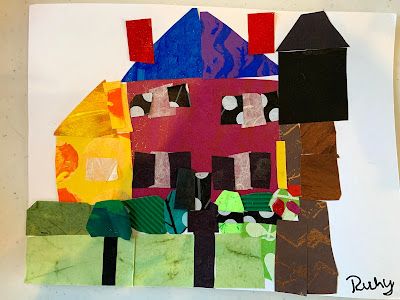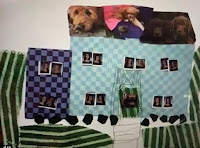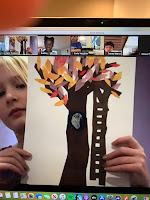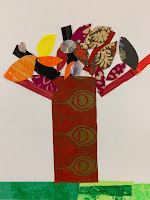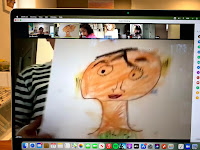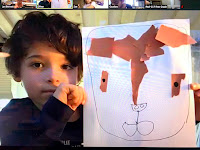Love and Kindness are in the Air at CHS!
Also, there is worry and concern as we wonder what the near future holds. In the event that you find your family at home with a lot of time to make art, here is a list of great materials to have on hand at home and a few ideas of things to create. Creating can be a great calming activity and distraction for anxiety -- for you and your children!
Basics:
paper of different sizes and thicknesses, white and colored
thick and thin felt tip markers
crayons
colored pencils
oil pastels -messier, baby wipes are good for hands while using
collage paper- old magazines, old wrapping paper, old newspapers, tissue paper, origami paper
scissors that work- round tips for younger kids
stapler
hole puncher
masking tape, decorative tape, any tape
odds and ends - small pieces of wood, cardboard, pipe cleaners, or other soft wire, pieces of ribbon and yarn, buttons
natural items like acorns, pine cones, twigs and stones
Additional items:
Painting for younger children- Buddha Board (on Amazon- only water used on it)
Painting for older children - Watercolor pallets, watercolor pencils or crayons
3D Construction is fun with small pieces of cardboard and masking tape until children are old enough to handle a glue gun. Glue Guns should be supervised. I use them with 2nd and third graders who are ready- supervised.
Model Magic- air dry modeling clay. You can make a cardboard base and then put model magic on it and stick tooth picks, brads, and paper clips into it.
Ideas to spark creativity:
take some chalk outside, wet or dry
get out the watercolor paints
keep a drawing journal ( I liked sharing one with my kids when they were little and we sent messages back and forth to each other through drawings and words. It was on the breakfast table to greet them each morning)
get a white board and markers for drawing
make a weaving loom out of a cardboard box (a cereal box is easier to cut into)
make a hide-out from a large box and decorate it
draw in the sand or dirt
make a sand castle (it you have a sand box or are at the beach!)
make a collaborative drawing on a napkin
get some air-dry clay and create small sculptures
dumpster dive and make a cool recycle object of art
read a book and imagine the pictures...then you can illustrate it.
Primary Artists: After exploring color and lines, the Primary Artists are beginning to focus on visual textures in the Art Room. We read a book about collage in class, Colette: A Collage Adventure by Kathryn Horn Coneway; and now the students are busy making different textured paper to use in collage. They created crayon rubbings, painted paper with texture tools and paint rollers, and bubble wrap prints. Once we've made all of the different textures, we will start making some collages out of these materials!
Kindergarten Artists: In the winter the kindergarten students created model magic snow people. They added paper clips, buttons, beads, feathers and yarn to give them personality! Yarn bombing was out next exploration. The students heard the book, Extra Yarn, by Mac Barnett and illustrated by Jon Klassen. After this unusual story they were surprised to learn that there really are places where trees and bicycles wear sweaters! In preparation for some watercolor painting, the students learned about special techniques they can use with watercolor to create visual textures including oil pastel resist, tape resist, and various types of blotting. They enjoyed moving around to different watercolor stations to explore these various techniques. At the culmination of this learning the students identified these techniques in each other's work and made their learning visible.






First Grade Artists: The first grade artists were very invested in their "Not a Box" Challenge. After reading a book about imagining a box to be all sorts of things (a car, an airplane, a house, etc.), the students painted boxes and then added found objects to create an extraordinary construction. They planned their projects by drawing ideas, picking their favorites and then interpreting the plans in the final 3-D piece. It was especially fun to have some third grade students assist them with the glue guns! After displaying the box creations with their "artist statements", the first grade artists continued to travel the world in art class, parallel to their classroom studies. Japanese Kimono Paintings were created based on their knowledge of Japan and Japanese art's focus on nature. While in Australia they created ceramic boomerangs. These boomerangs are objects of art, not to be actually thrown (much to their disappointment!).








Second Grade Artists: Second Grade Artists have been creating art related to their Native American Social Studies in the classroom. They created Cooper-foil Copper Foil Medicine Pouches using special tools to imprint Native American symbols into their pouches. The students enjoyed working with some new materials and creating in an unfamiliar way, rising to the challenge of stretching their comfort zones! After our pouches, the students made individual weavings and were remarkably skilled at keeping the tension even. Coming up are ceramic pots and ceramic "animal fetishes" (small animals decorated with beads and feathers who are thought to have special powers- somewhat like a good luck charm, but more spiritual).






Third Grade Artists: One of the highlights of the third grade this year has been their visit to the East Wing of the National Gallery to see the Calder Exhibit, arranged by their classroom teachers. Inspired by the exhibit, the students created poetry in their classroom, mobiles in the maker space, and "Found Object" Circuses in art. They have been working on the circuses for several weeks in teams of four, and have been learning a lot about planning, organizing, creating, and assessing their work as a group. In addition to these skills, they are using their imaginations to visualize and collaborate in order to incorporate each of their visions into one project! Here are some photos of their work in progress:






MOREART: If you are planning to enroll your child in MOREART for the Spring Session, please watch for registration information coming from the school. MOREART is part of the Afterschool Activities Program. The Spring Session is for First Graders, Kindergarteners, and any Second Graders who could not get into the Winter Session. Your child can go from art to Cub Club when the class ends at 4:20.
Enjoy your creating!
Jan
